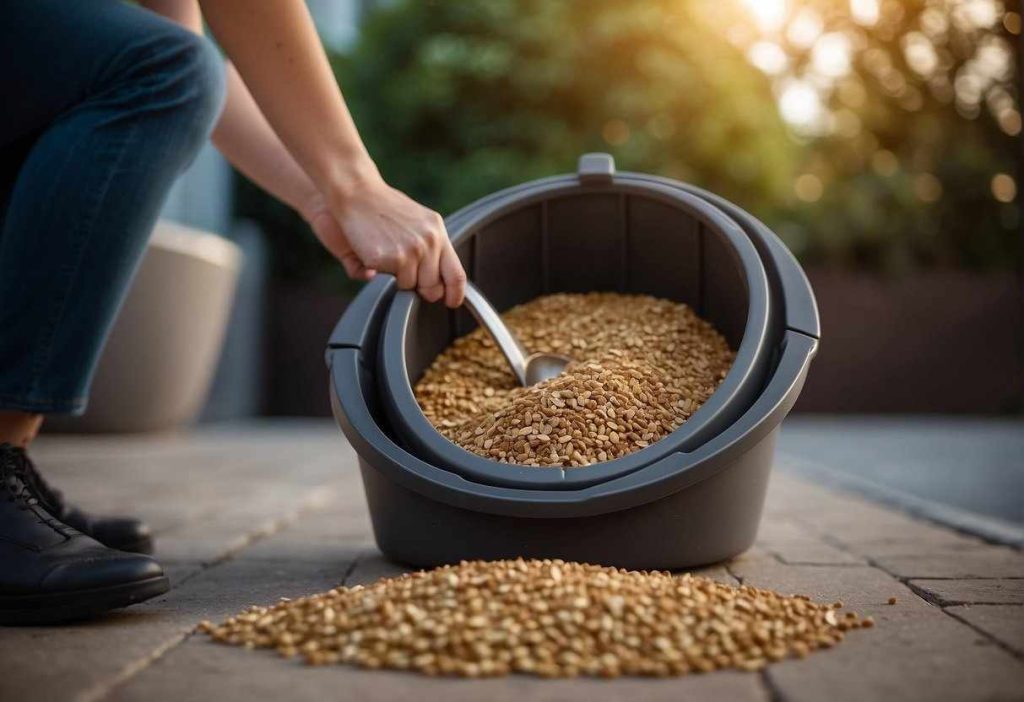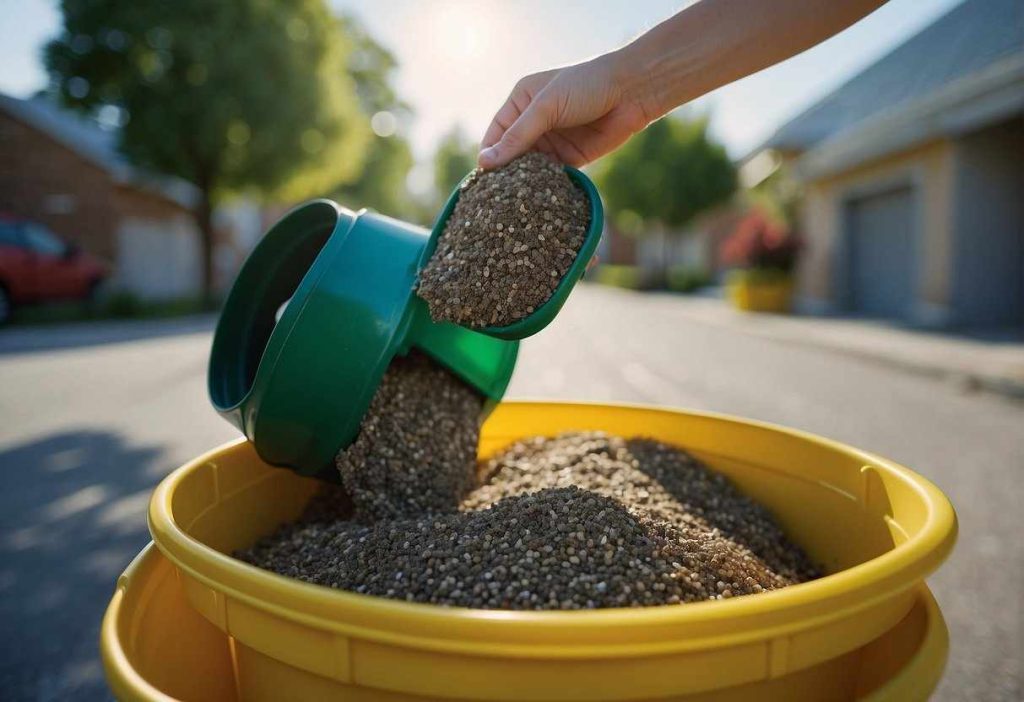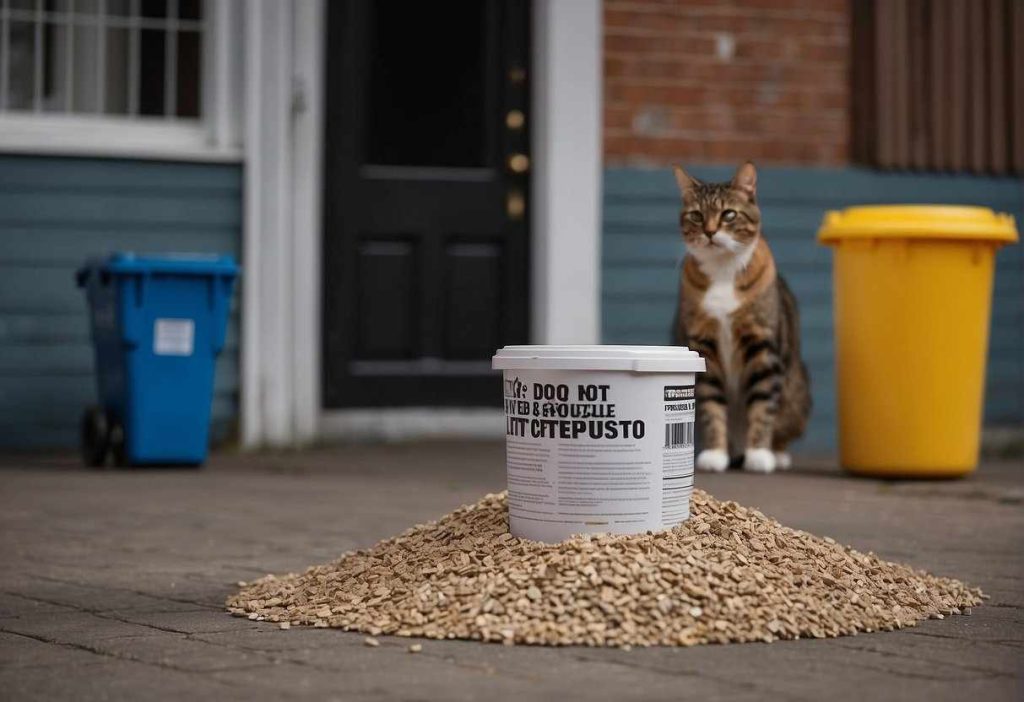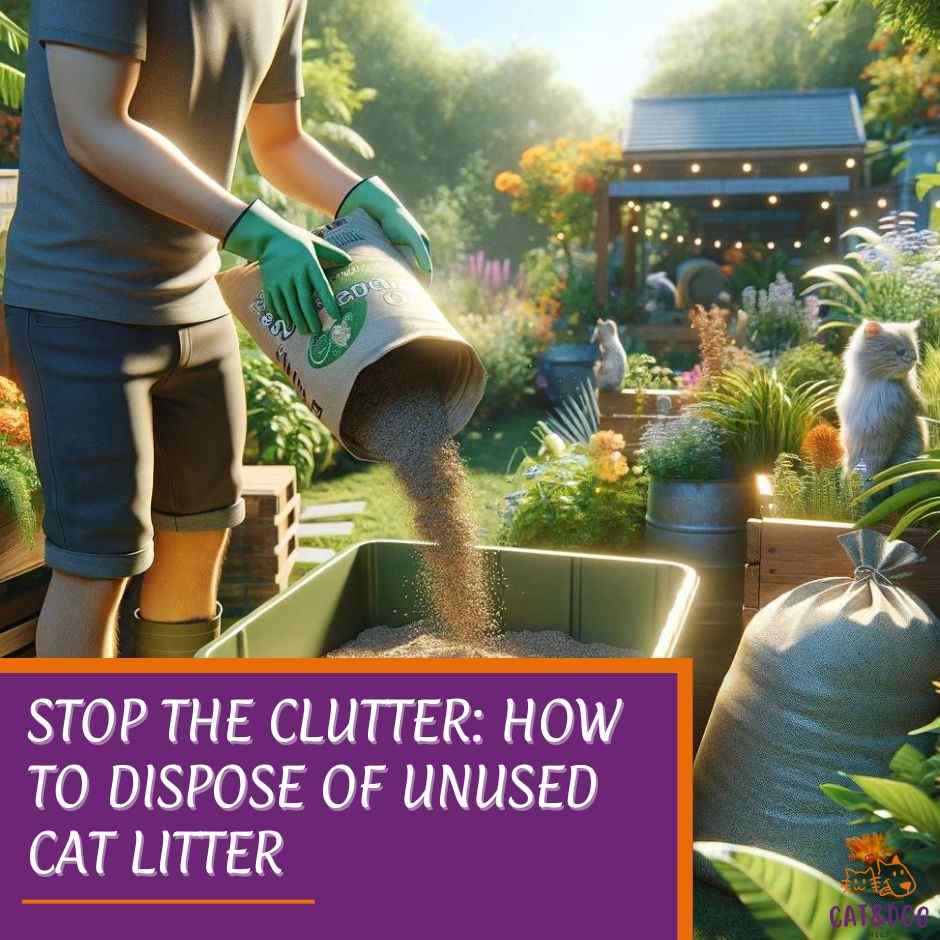Caring for your feline friend includes more than just feeding them and playtime; it also involves dealing with a dirty litter box. So, how to dispose of unused cat litter?
With a steady increase in cat ownership, as reported by the American Pet Products Association, there’s a noticeable upsurge in cat litter usage.
But have you ever wondered about the best way to dispose of that unused cat litter gathering dust on your shelf?
It’s not just about keeping your home odor-free—proper disposal of dirty cat’s litter box is important for the environment and health reasons, too.
Using a cat litter scoop, it’s a great option to easily remove the waste from the litter box and place it in a plastic bag before putting it with the rest of your trash.
Make sure you wear gloves and a mask to protect yourself from harmful bacteria and dust from the litter.

Let’s chat about that unused cat litter. It’s not the most glamorous topic, but it’s definitely a part of the ‘cat parent’ job description that can’t be ignored.
While many resources focus on how to dispose of the clumps and waste from your cat’s litter box, little attention is given to the right way to get rid of clean, unused litter that you no longer need, including unused cat feces.
Whether it’s due to a brand switch or a litter type that didn’t mesh well with your kitty, knowing how to dispose of unused litter, including unused cat feces, is essential for maintaining a healthy and eco-friendly water supply.
One option for disposing of unused cat litter is to flush it down the toilet, but it is important to note that this can be harmful to the environment. (1)
Cat feces can contain harmful bacteria and parasites that can contaminate water sources, so it is recommended to only flush cat litter if you live in an area with a good sewage treatment system and if you use a flushable litter that is specifically designed for this purpose.
Key Takeaways
- Proper cat litter disposal is crucial for environmental and personal health.
- Unused litter requires specific disposal methods separate from used litter.
- Disposing of unused litter responsibly reflects the rising conscientiousness among cat owners.
Practical Solutions for How to Dispose of Unused Cat Litter

Let’s explore some practical ways to put that litter to good use without sending it to the landfill!
Donating Unused Cat Litter
How to Donate
- Finding Local Shelters and Their Requirements Research: Start by looking up animal shelters and rescues in your area.
- Call Ahead: Give them a quick call to confirm their need for cat litter.
- Prepare for Donation: Ensure the litter is unopened and includes its original packaging for the shelter’s safety protocols.
Curious about what else you can do? Here’s a neat trick!
Repurposing Unused Cat Litter
Creative Uses in Home and Garden
- As a Soil Amendment for Non-edible Plants (2)
- Give your potted plants a little love by sprinkling a small amount of cat litter at the bottom for improved drainage.
- For Traction on Icy Sidewalks and Absorbing Spills
- Keep a bag in the trunk of your car. If it gets slippery out there, spreading some litter can provide much-needed traction.
- Had a spill in the garage? Cat litter can help soak up oils and other liquids.
Selecting the right disposal method for unused cat litter also plays a crucial role in effective litter odor control, ensuring that unwanted smells are kept at bay, even when dealing with litter that won’t be used.”
Remember, your unused cat litter doesn’t have to go to waste.
By donating to local shelters or finding creative ways to use it around your house, you’re not just helping the environment but potentially aiding furry friends in need as well. It’s a win-win!
Eco-Friendly Disposal Methods for Used and Unused Litter

Recycling and Eco-Friendly Purchasing
Wondering what to do with that unused kitty litter sitting in your garage? If it’s made from recycled paper or natural materials, like sawdust, you’re in luck!
Believe it or not, some recycling programs may give your unused litter a second life. Check local resources to see if this option exists in your area.
And hey, you’re not just helping the environment; you’re helping your wallet too! Next time, consider buying your kitty litter in bulk to cut down on packaging waste.
It’s like hitting two birds with one stone – less trash and fewer trips to the store.
Another eco-friendly option is to use sustainable cat litter boxes, such as ones made from upcycled plastic tubs or purchased from a thrift store.
This not only reduces plastic waste but also gives a new purpose to items that would otherwise end up in a landfill.
Additionally, using sustainable cat litter boxes can also help reduce the amount of plastic used in traditional cat litter boxes, making it a more environmentally friendly option for disposing of used cat waste.
Composting Biodegradable Cat Litter
Got a green thumb? Biodegradable cat litter can become a part of your garden routine. Well, kind of – and definitely not the part that grows tomatoes! (3)
Safely composting cat litter means keeping it away from your edible plants since it may contain pathogens that you don’t want near your veggies, including fecal matter and parasites such as Toxoplasma Gondii. (4)
So how do you start?
First, it’s important to know the types of litter that are biodegradable and able to be composted, such as clay-based litter, corn-based litter, wheat-based litter, and litter made out of compressed paper.
- Find a suitable spot for your compost bin, away from food gardens.
- Add your biodegradable litter to the bin along with your usual yard waste.
- Regularly turn the compost to help it break down.
Meet Jane, a cat owner who swears by composting. Her flower garden has never been happier with the added nutrients! Just remember, she keeps her litter compost strictly for non-edible plants to keep things safe.
There you go! Whether you’re a recycling hero or a budding composter, you’ve got options for that cat litter – and the planet thanks you for it.
Understanding Different Types of Cat Litter

Cat litter comes in various forms, and knowing the difference can make both your life and your cat’s a bit easier—not to mention it’s kinder to our planet!
Let’s break it down, shall we?
- Biodegradable Litter: This eco-friendly option includes materials like corn, wheat, and recycled paper. Quite impressive, right? If being kind to Mother Earth is your jam, then you’d be thrilled to know that these litters can decompose in about two months. Quick to break down, they leave behind far smaller paw prints on the environment than their clay-based cousins. (5)
- Non-Biodegradable Litter: Typically made from clay, these litters are the old-school types that might sit in a landfill for several years before breaking down. They’re like that guest who overstays their welcome at a party, wouldn’t you say? The main challenge is disposal since you can’t just toss them into your compost bin. They need to be bagged up and taken out with the trash, which isn’t exactly a high-five moment for nature. (6)
So, you’re probably thinking, “What’s the best pick for my kitty?” Well, it depends on your preferences and lifestyle.
Biodegradable litters are gentle on the planet and often easier on your conscience, while clay litters are a tried and true option, albeit a bit tougher on the environment.
Remember, no matter which litter type you lean towards, always use a biodegradable or compostable bag for disposal if possible. It’s a small step but can make a big difference in reducing your ecological ‘catprint’!
How to Dispose of Unused Cat Litter: Safe Disposal Practices
Ever wondered how to dispose of unused cat litter without turning your trash can into a feline wasteland? Let’s break it down.
Health and Safety Considerations
When handling cat litter, remember:
- Minimize dust by scoop-scooping rather than pouring, a pro move for your lungs!
- Chemical exposure? Not on our watch. Wear gloves, and don’t get too close to the action.
Pro tip: Store your litter in a cool, dry place. Keep that quality pristine, like a cat’s reputation for cleanliness.
Disposal of Non-Biodegradable Cat Litter
Non-biodegradable litter can stick around longer than that awkward guest at your last party. Here’s the scoop:
Preparing Litter for Trash Disposal
- Double-bag it—because no one likes a surprise spill.
- Check local regulations. Are you a litter-law-abiding citizen?
It’s simple: bag, bin, and out of sight!
Handling and Storage
How do you keep your kitty’s bathroom material tip-top? Let’s fetch some tips:
- Use a dedicated scoop, and always have those bags handy.
- Store the unused loot in sealed containers. Cats hate stale litter almost as much as stale memes, right?
Disposing of cat litter may not be glamorous, but doing it right? That’s being a responsible pet parent and neighbor.
Keep these tips in your kitty care toolkit, and you’ll be on the fast track to a cleaner, greener feline routine. Happy scooping!
Addressing Environmental Impact

Reducing Environmental Footprint
You’re already taking a great step just by being here! Opting for eco-friendly litter brands is a move that Mother Nature would surely purr in approval of.
- Eco-Friendly Litter Brands:
- Say goodbye to traditional clay-based litters and hello to greener options! Here are some popular choices:
- Yesterday’s News: Recycled paper turned into litter, how cool is that?
- World’s Best Cat Litter: Corn-based and biodegradable, your cat won’t know the difference, but the planet will. (7)
- sWheat Scoop: Made from wheat, and it’s flushable too!
Tips for Reducing Overall Litter Use
- Are you over-pouring? Measure your litter to avoid waste.
- Scoop regularly so you can replace it less often.
Encouraging Sustainable Pet Care Habits
- Bring your cat indoors to reduce hunting and its impact on wildlife.
- Train your kitty to love a sustainable litter option; patience pays off!
Remember, every small step leads to a larger leap for sustainability.
While we’ve yet to invent a zero-impact litter, your efforts in choosing and minimizing the use of cat litter send a message that you care about our earthy litter box — the environment. Happy scooping, eco-warrior!
Additional Resources

Where to Learn More:
- American Society for the Prevention of Cruelty to Animals (ASPCA): Visit ASPCA’s website for pet care tips.
- Environmental Protection Agency (EPA): Curious about your paw print on the planet? Explore EPA’s resources on environmental impact.
Local Helpers:
- Recycling Centers: Not sure if they’ll take cat litter? Give ’em a ring! Local recycling centers can provide the do’s and don’ts of recycling.
- Animal Shelters: Sometimes shelters can use unused cat litter. It’s always worth asking! Here’s where to find them:
Dispose with Ease:
Need to talk trash…literally? Your local waste management services are just a call away. Dial-up and inquire about the proper disposal methods to stay neighborly and eco-friendly.
Remember, keeping our feline friends happy doesn’t mean turning a blind eye to Mother Earth. Thanks for doing your part! 🐾✨
Quick Recap

Used Litter? Bag it Up! First off, for the used litter, grab it with a scoop, plop it into a biodegradable bag (yeah, let’s keep it green), and send it off in your outside trash with a snug lid. Easy, right?
- Step 1: Scoop poop and urine clumps
- Step 2: Bag in biodegradable/compostable bags
- Step 3: Seal and double bag to prevent odors
- Step 4: Discard in an outdoor trash can with a lid
For Unused Litter… Got too much-unused litter on your hands? It’s simple:
- Donate it: Shelters are always in need!
- Compost it: Only if it’s 100% natural! No clumping or chemical-based litter here.
- Trash it: In the trash, it goes—but make sure your area allows it.
While we’re on the topic, choosing litter that’s eco-friendly or even flushable (for some natural types) can make a big difference. It’s all about little changes, right?
Remember to always follow local disposal guidelines to keep our environment clutter-free. You’ve got this! Keep it practical, stay safe, and always lean towards an eco-conscious choice.
Frequently Asked Questions

When it comes to unopened cat litter, you might have a few questions about what to do with it.
Whether you’re looking to be eco-friendly, hoping to help out your local shelter, or just curious about storage, I’ve got you covered.
Can I donate open but unused cat litter to animal shelters?
Yes, you can! Most animal shelters welcome donations of opened but unused cat litter, as long as it is still clean and in good condition.
It’s best to call ahead and check with your local shelter to see if they can accept your donation.
Are there any eco-friendly cat litter brands you recommend?
While I don’t endorse specific brands, look for eco-friendly cat litter made from recycled paper, wood shavings, or corn.
These materials are biodegradable and better for the environment.
How can I repurpose unused non-clumping cat litter?
Get creative! Unused non-clumping cat litter can be used for traction on icy sidewalks, as a moisture absorber in musty areas, or even in the bottom of a trash can to neutralize odors.
Is it safe to compost unused cat litter?
This depends on the material. If the unused cat litter is made of natural, compostable materials like wood or paper, it can be safe for composting.
However, avoid composting cat litter if it has added chemicals or scents.
What should I do with unused clumping cat litter?
If you’ve switched to another type and have leftover clumping litter, consider using it to absorb oil spills in the garage, or keep a bag in the car during winter months for added weight and use if you get stuck on ice.
Can unused cat litter be recycled?
The recyclability of unused cat litter depends on its material. Non-clumping litter made from recycled paper can often be recycled again.
Clumping litter, however, is usually not recyclable due to its chemical composition.
How do I store unused cat litter to maintain its quality?
Keep your unused cat litter in a cool, dry place away from moisture.
Ensure the packaging is properly sealed or store it in an airtight container to prevent it from clumping or becoming unhygienic.


